
On the morning of October 25 (November 7), the proletariat was in command of all the decisive and tactically important points of the capital. Only the Headquarters of the Petrograd Military Area and the Winter Palace were left in the hands of the government. The insurrection was successful. At 10 a.m., the Military Revolutionary Committee issued the following manifesto to the citizens of Russia:
“The Provisional Government has been overthrown. State power has been transferred to the organ of the Petrograd Soviet of Workers’ and Soldiers’ Deputies—the Military Revolutionary Committee—which is at the head of the Petrograd proletariat and garrison.
“The success of the cause for which the people have been fighting—the immediate offer of a democratic peace, the abolition of landlordism, the institution of workers’ control of industry and the formation of a Soviet Government—is ensured.
“Long live the workers’, soldiers’ and peasants’ revolution!”[1]
The manifesto was signed by Vladimir Ilyich Lenin.
That very morning the manifesto was telegraphed to all the industrial centres. It exercised enormous revolutionary influence upon the working class throughout the country and facilitated the rapid transfer of power to the local Soviets. Wherever the news of the victory in Petrograd penetrated, the masses of the proletariat rose up for the struggle.
The forces of the Military Revolutionary Committee steadily grew. At the Smolny reinforcements arrived from the working-class suburbs. All the districts sent detachments. Transport facilities were obtained and stocks of arms and provisions were laid in. Arms were quickly obtained from the arsenal in the Fortress of Peter and Paul and conveyed to the different factories.
Meanwhile, work at the factories continued and the tram service was maintained without interruption. Just before the insurrection the Petrograd wood-workers went on strike. On the day of the insurrection, however, the strike committee called upon all the strikers to resume work forthwith. The resolution adopted by the committee stated:
“During these days, every worker must be at his post and prove his loyalty to the new government.”[2]
A strike was also in progress at the sawmills in the Narva District, but members of the strike committee came to the Committee of the Bolshevik Party and stated that they were calling off the strike, that they desired to join in the insurrection, and placed themselves at the service of the Military Revolutionary Committee. They were forthwith instructed to organise a detachment and send it to the Smolny.

The telephones in the offices of the factory committees rang continuously; the district staffs of the Red Guard were calling out the detachments. The Red Guards captured the last remaining government offices in the city and its environs.
The Red Guard detachments of the Rosenkranz Works and Metal Works disarmed the cadets of the Mikhailovsky Artillery School. In the Narva District, the Red Guards occupied No. 2 Gorokhovaya Street, the offices of the Chief of Police of Petrograd. The revolutionary troops captured the trunk telegraph line connecting Petrograd with Moscow, Kiev, and Reval. In the Vyborg District the workers occupied the Kresty Prison and released the Bolsheviks who had been arrested and confined there by the Provisional Government in July. A detachment from the Sestroretsk Small Arms Factory received the order to disarm the cadets at the Military Engineers’ School.
The revolutionary troops occupied the Central Firearms Depot. From here cases of revolvers were taken and distributed to the factories. The Putilov Shipyard received a thousand, and a large quantity was also received by the Franco-Russian Works. Fresh detachments of Red Guards were dispatched to the Smolny.
The streets in the working-class districts were thronged. Here and there groups gathered and animatedly exchanged impressions of the events of the last few hours. Motor trucks filled with armed soldiers and workers dashed through the streets scattering copies of the manifesto of the Military Revolutionary Committee. The streets near the centre of the city were quieter. The Nevsky Prospect was deserted. The patrols would not allow anyone to pass beyond the Kazan Cathedral. Here the tension of an unfinished battle was felt.
Lenin demanded that the last places of refuge of the Provisional Government—the Winter Palace and the Headquarters of the Petrograd Military Area—should be occupied as speedily as possible. Representatives of the Military Revolutionary Committee went to the factories to rally the workers and to organise fresh detachments of the Red Guard.
The Petrograd garrison detailed its strongest units to capture the Winter Palace. At 11 a.m. on October 25, anti-aircraft guns were brought to the Smolny. The Armoured Car Detachment which had come over to the side of the Military Revolutionary Committee also arrived at the Smolny and was immediately dispatched to the palace.
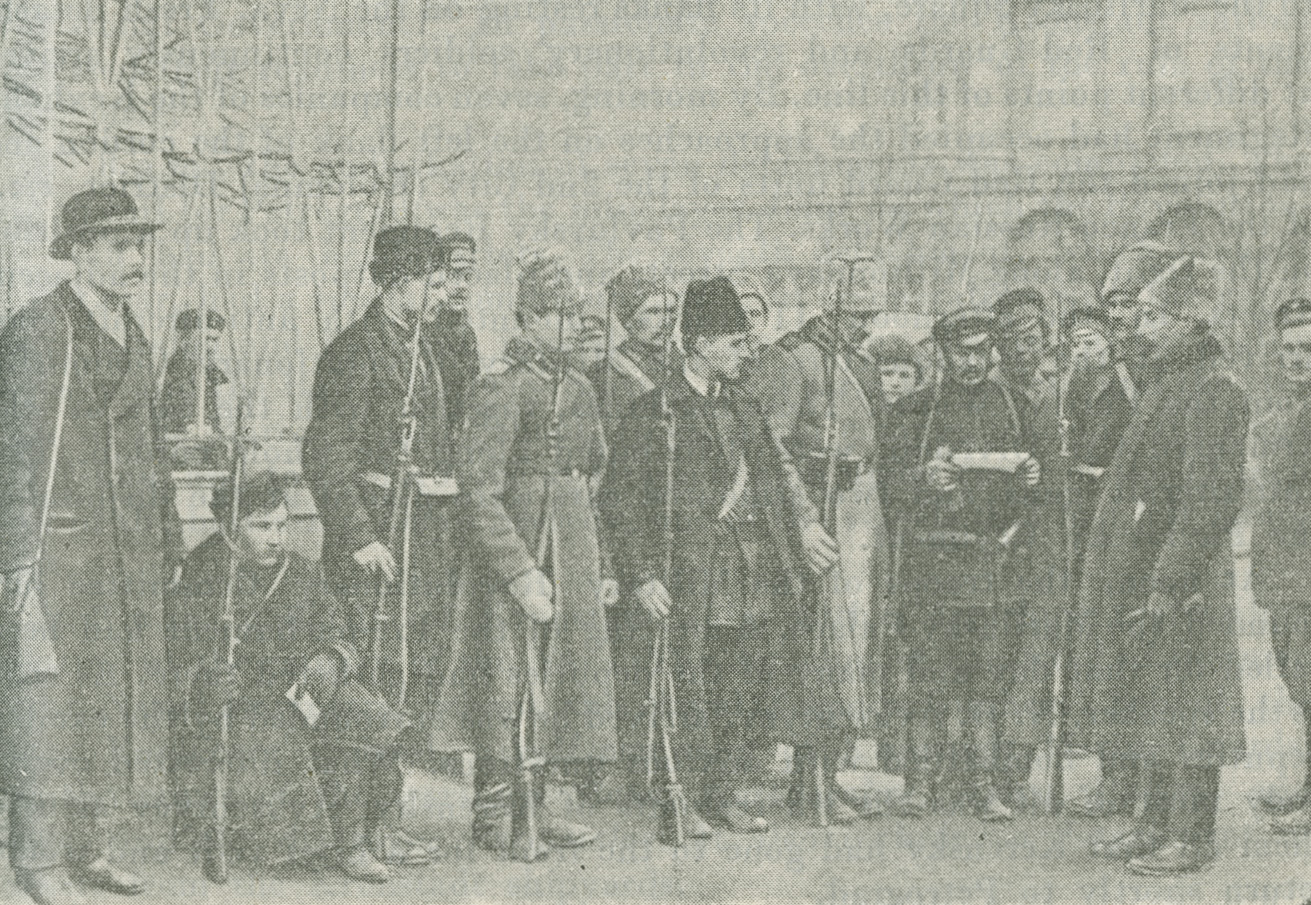
The 6th Rear Automobile Repair Company sent a representative to the Smolny to announce its adherence to the insurrection. The company was ordered to facilitate the transfer of Red Guards and troops to the Winter Palace, and to transport arms to the working-class districts. The company’s garage immediately sent trucks, which they had refused to send to Military Area Headquarters on the pretext that they were out of repair. At noon, the ring around the Winter Palace and Military Area Headquarters began to close in. The line ran from the river Moika, through the Field of Mars to the Mariinsky Square, with its flanks resting on the Neva. Fresh detachments of Red Guards and revolutionary soldiers continuously arrived at different points of this line. By morning, seven companies of the Kexholm Regiment had occupied the approaches on the left flank of the cordon and had joined the Red Guard units of the 2nd City (Kolomna) District, viz., of the Franco-Russian Works. The Pavlovsky Regiment took up a position on the right, along Millionnaya Street, and placed outposts in the adjacent streets. In the afternoon 11 trucks, mounted with anti-aircraft guns arrived at the Headquarters of the Military Revolutionary Committee from the Putilov Works. These machines, together with the cars of the Armoured Car Division, were distributed along the whole cordon. Two anti-aircraft guns and two armoured cars were placed at the disposal of the Pavlovsky Regiment.
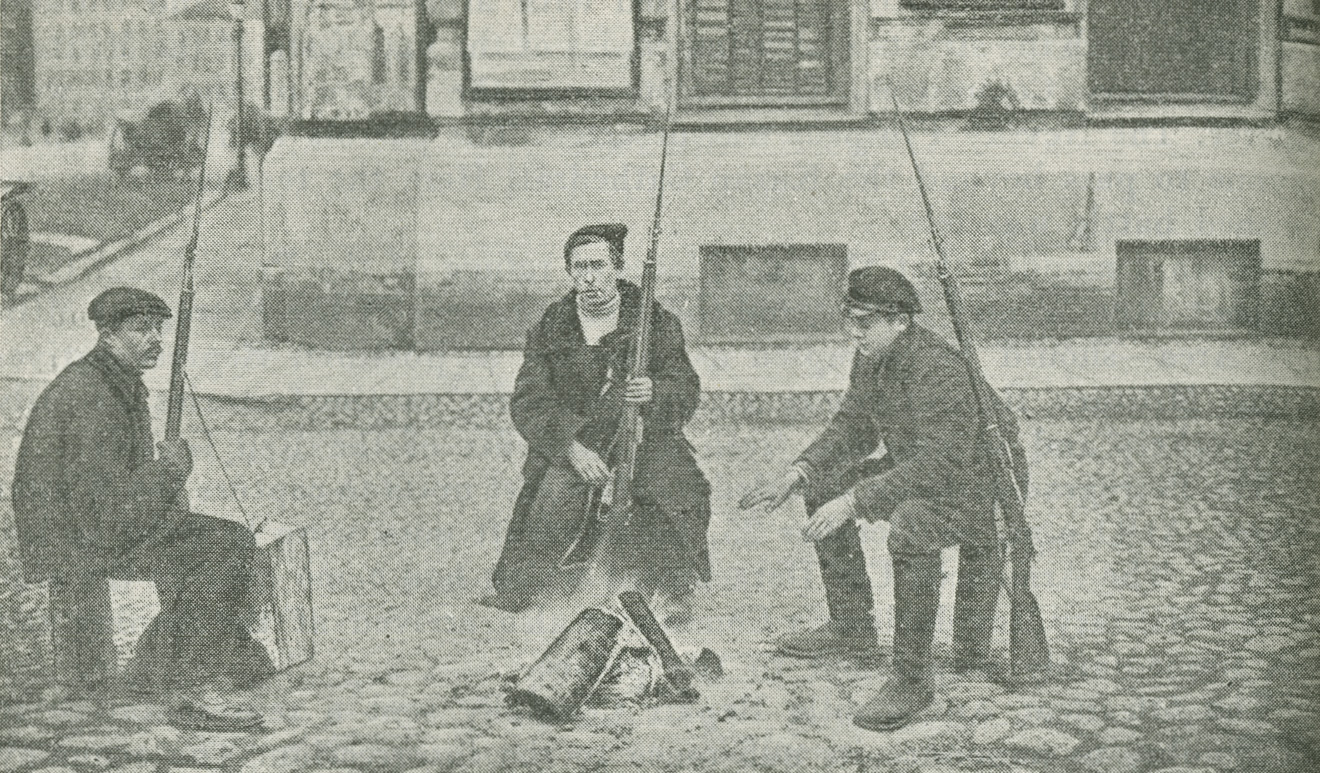
At noon, the troops of the Military Revolutionary Committee surrounded the Mariinsky Palace. A meeting of the Pre-parliament had been called for that day and many of the deputies had gathered there. As soon as the speaker, N. D. Avksentyev, arrived he was surrounded by the excited deputies and bombarded with anxious questions. What interested everybody most of all was the whereabouts of Kerensky. Avksentyev assured them all that Kerensky had gone to the front for a brief visit and would return shortly to Petrograd.
Suddenly, the news was received that the palace was surrounded by Red Guards and a company of the Lithuanian Regiment. Later, companies of the Kexholm Regiment and of the Marine Guards, supported by an armoured car, arrived. The deputies were ordered to leave the premises. Avksentyev hastily called a meeting of representatives of the different political groups, at which it was decided to express an emphatic protest against the resort to force. After the meeting Avksentyev managed to run into the Chamber where about 100 deputies were gathered. By a majority vote the deputies resolved to “yield to force” and disperse. As soon as the deputies left, the palace was occupied by the revolutionary detachments.
The soldiers demanded the arrest of the Constitutional Democrats, but the commander, who examined the deputies’ papers, replied: “We shall always have time to arrest those who warrant arrest.”[3]
Detachments of sailors hastened to the assistance of the Petrograd proletariat. On the evening of October 24, a special meeting of the Kronstadt Executive Committee of the Soviets was held. After hearing the report of the delegates of the Military Revolutionary Committee on the situation in the capital, the meeting decided forthwith to send a mixed unit of sailors of the Baltic Fleet to Petrograd. A number of measures were decided on to ensure the Soviet complete control in Kronstadt. At 1 a.m. the general meeting of the Soviet approved the proposal of the Executive Committee. Early in the morning of October 25, a huge mass meeting was held in Yakornaya Square. Above the heads of the vast crowd waved flags and streamers bearing the inscriptions: “Long Live the Power of the Soviets!” “Down with the Provisional Government!” In passionate speeches the Kronstadt sailors expressed their readiness to take part in the overthrow of the rule of the bourgeoisie.
By 8 a.m., the embarkation of seven detachments was completed. The first to sail for Petrograd was the minelayer Amur on which the Revolutionary Staff had its headquarters. The seventh detachment, which brought up the rear, had a special commission, viz., in co-operation with the garrison of Strelna and Peterhof, immediately to occupy the line of the Baltic Railway and the Baltic Railway Station, to disarm the cadets and the students at the Marine Guard School, to establish communication with Luga and Pskov, and to land a force at Oranienbaum under cover of the 12-inch guns of the battleship Zarya Svobody, one of the vessels that had left Kronstadt.
At 2 p.m., a flotilla of Kronstadt ships with a detachment of sailors appeared at the estuary of the Neva. The detachment consisted of the men of the Naval Engineers’ School, the Naval Torpedo Gunners’ School, the Motor Engineers’ School, a half-company of Kronstadt Marine Guards, and the crews of the warships Slava, Narodovolets, Aziya, Pulkovo and Okean, and the destroyer Pryamislav. It also included a detachment of workers from the Kronstadt shipyards.
The active Baltic Fleet sent five fighting ships, headed by the cruiser Oleg.
As had been arranged, the battleship Zarya Svobody stopped at Ligov where, under cover of her 12-inch guns, the seventh detachment of sailors landed at the Lifeboat Station and began to disarm the cadets of the Oranienbaum and Peterhof Military Schools. At 8 p.m. the sailors arrived in Petrograd, having occupied the whole line of the Baltic Railway.
The Helsingfors Detachment, which arrived in Petrograd by railway, consisted of 1,500 sailors. Among them were men from the Coastal Mine Defence Company, sailors from the warships anchored at Helsingfors, commandos of Sveaborg Marine Guards and commandos from the Helsingfors hospital.
The Petrograd sailors occupied the Naval Port with its radio station, and the new Admiralty, where the leading Naval Staff officers were arrested.
After Kerensky’s departure Konovalov presided at the meetings of the Cabinet in the Winter Palace. The Cabinet decided to remain in the Winter Palace and to defend it until the arrival of the troops from the front. An appeal to the country was drawn up on those lines. It was deemed necessary to dismiss Colonel Polkovnikov.
Stankevich, the Supreme Commissar of General Headquarters, communicated with General Dukhonin by direct wire, enquiring whether the troops that had been requested were coming. The latter answered that the troops had been dispatched and would soon reach Petrograd.
“Have you really not yet received news of their approach?” asked Dukhonin. “I have been informed that you have sent somebody out to meet them. . . . What is the Constantinovsky Military School and the Nikolayevsky Cavalry School doing? Probably there are others. . . . I think you ought to be able to find sufficient forces. All you have to do is to organise this business properly; meanwhile the troops from the front will arrive. . . .”
“I think,” answered Stankevich, “that the commanders of the approaching echelons should be advised that if the Staff of the Petrograd Military Headquarters are unable to give them instructions on their arrival they should leave a guard at the railway station and immediately proceed to Area Headquarters and to the Winter Palace, in spite of any obstacles they may encounter in the streets.”
Dukhonin ended the conversation by saying:
“I think it is essential to send trustworthy persons from Petrograd to meet the approaching troops two or three stations before Petrograd. . . . Moreover, I have asked Shtasev (abbreviation of Staff of the Northern Front—Ed.) to send representatives of Army or Front Committees with the troop trains.”[4]
General Bagratuni, Chief of Staff of the Military Area, summoned to the meeting of the Cabinet, reported that there were too few troops to defend the government. They could rely only on those forces which were concentrated at the Winter Palace. The Cabinet decided to appoint a special commissioner for the defence of the Provisional Government. The Menshevik Nikitin nominated Palchinsky for this post, but the majority, including the Socialist-Revolutionary and Menshevik Ministers, voted for the Constitutional Democrat Kishkin, who at the Congress of the Constitutional Democratic Party held in Moscow in the autumn of 1917, had promised to “infuse spirit” into the government. Subsequently, Nikitin explained Kishkin’s appointment as follows:
“Evidently he was appointed because, being a Cadet, it would have been easier for him, morally, to undertake the responsibility of issuing order for bloody reprisals than it would have been for the Socialist Ministers.”[5]
This once again exposes the mean and despicable souls of these petty-bourgeois politicians. Preparing for bloody reprisals against the working class the Socialist-Revolutionaries and Mensheviks put the arrangement of this in reliable hands. In the event of failure, they would be able to wash their hands of the affair and throw the blame on the Constitutional Democrats.
P. Palchinsky and P. Ruthenberg were appointed Kishkin’s assistants. This newly hatched military dictator, jointly with Palchinsky and the Chief of Staff of the Petrograd Military Area, immediately began to take defensive measures. Kishkin dismissed Colonel Polkovnikov and set to work himself to organise the defence of the Winter Palace until the arrival of the troops from the front; but not even a plan of the palace was available. The fighting spirit of the officers and cadets dwindled. In his memoirs Palchinsky noted “consternation and apathy among the officers, and dismay among the cadets.”[6]
To rouse the spirit of the cadets they decided to make a sortie. Stankevich took a company of cadets from the Engineer Officers’ Training School to recapture the Mariinsky Palace, but when they got there they found it guarded by armoured cars. Stankevich, however preferred to have a try at the Telephone Exchange in Morskaya Street. Breaking up into two half-companies, the cadets thought they would be able to surprise the guard at the Exchange. “Those yokels will see that we are in earnest and they will at once climb down,”[7] said Stankevich, sending one half-company by a roundabout route, and himself leading the other to the building by the direct route.
But the “yokels” caught sight of the cadets and sounded the alarm. A machine gun was turned on the approaching cadets and the entire half-company at once scattered. Soon firing ceased. The telephone girls flocked into the street and informed the cadets that the Exchange was full of soldiers who controlled all telephone conversations.
The cadets were preparing to return to the attack, but at this juncture a secretary of the French Embassy arrived and warned them that their rear was threatened. Red Guards armed with machine guns had taken up a position at the corner of Gorokhovaya Street and the Moika. Stankevich requested the secretary to inform the other half-company and the Winter Palace, and hastened to withdraw. The other half-company was surrounded by Red Guards on the Nevsky Prospect and disarmed.
The sortie failed. This was the only attempt of the forces of the Provisional Government to engage in active operations. After this fiasco, the government locked itself in the palace and took to the defensive, in expectation of the arrival of reinforcements from the front.
At about 2 p.m. on October 25 (November 7) Nikitin, the Minister for the Interior, rang up the City Council from the Winter Palace. Taking advantage of the inexperience of the Revolutionary Military Committee’s controller, the Telephone Exchange operator stealthily put Nikitin through. He informed the Council of the occupation of the Telephone Exchange and requested that representatives of the Council be sent there. He also demanded assistance, primarily provisions.
At the City Council the second meeting of the “Committee of Public Safety” was opened at 3 p.m. The first meeting had been held in the morning, and it had been decided to organise local “Committees of Public Safety” in all the districts, to be headed by the Chairmen of the District Municipal Councils. The question had also been raised of organising house committees, ostensibly for the purpose of protecting the lives and property of the inhabitants.
At the second meeting of the “Committee of Public Safety” it was decided to organise what was called a Civil Guard, consisting of property-owners, government officials and office clerks. It was also proposed that a supplementary “bourgeois guard” be formed. Lieutenant U. P. Mazurenko, who commanded the Provisional Government’s punitive detachments in the July days, was appointed chief of the Civil Guard.
At this meeting Schreider, the Mayor of Petrograd, reported that he had received a request for aid from the Minister for the Interior, Nikitin. The “Committee of Public Safety” immediately dispatched a truckload of provisions, but this was intercepted by the revolutionary patrols. Two members of the City Council—A. D. Korotnyev, a Constitutional Democrat, and Zakharov, a Socialist-Revolutionary, were sent to the Telephone Exchange. At 3 p.m. the City Council’s cars appeared in Morskaya Street but the drivers, fearing that they would be fired at, categorically refused to go any further. The Councillors were obliged to get out and walk. On reaching the Telephone Exchange these envoys of the “Committee of Public Safety” tried to calm the employees, and on behalf of the Council thanked them for their zealous and devoted service.
The intervention of the members of the “Committee of Public Safety” was cut short by the representative of the Military Revolutionary Committee who ordered the delegates to leave the premises forthwith. They complied, muttering that they regarded the action of the Military Revolutionary Committee as illegal, and that they were yielding only to force.
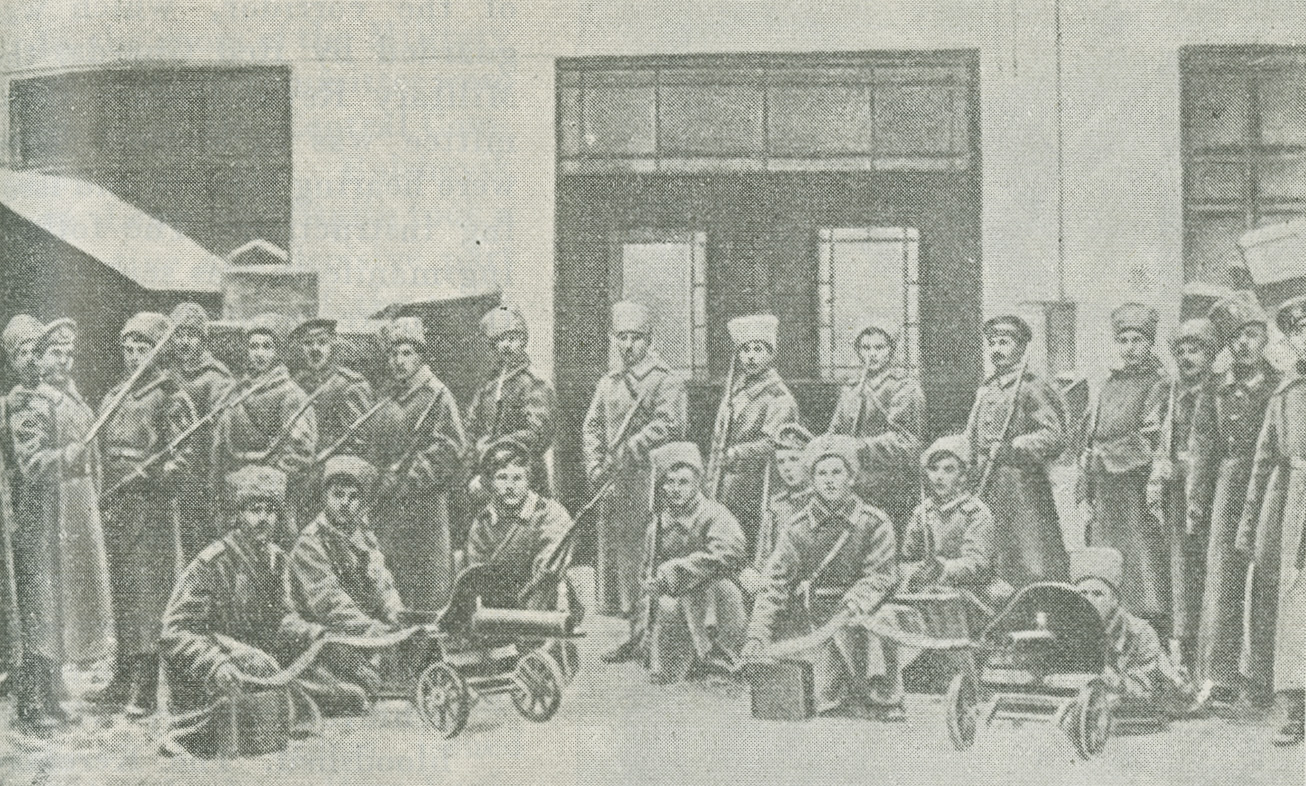
After his conversation with the City Council, Nikitin called up Moscow and asked to speak with Rudnyev, the Mayor. The latter informed him that insurrection had broken out in Moscow, but the City Council was issuing an emphatic protest against the seizure of power by the Bolsheviks.
Nikitin informed Rudnyev that the Provisional Government had decided to defend itself until the arrival of troops from the front, and requested him to maintain close communication with the Winter Palace and keep it regularly informed about the situation in Moscow. He added that the government had granted Rudnyev the same power to appeal to all the governmental institutions throughout the country as that enjoyed by the military authorities.
The Smolny, the headquarters of the proletarian revolution, was humming with activity. Every participant in the struggle devotedly performed his duty. Everybody was imbued with unshakeable confidence in victory. Detachments of Red Guards continued to arrive. Machine guns clattered in the long corridors. The rooms were filled with excited workers and soldiers. Exceptional animation prevailed outside the rooms of the Military Revolutionary Committee. Men passed in and out, coming for instructions or leaving hurriedly on various commissions. In the room at the extreme end of the corridor, which was guarded by Red Guards, the Military Revolutionary Committee was in session. They were hearing reports and issuing instructions. The following manifesto was sent out to the entire country:
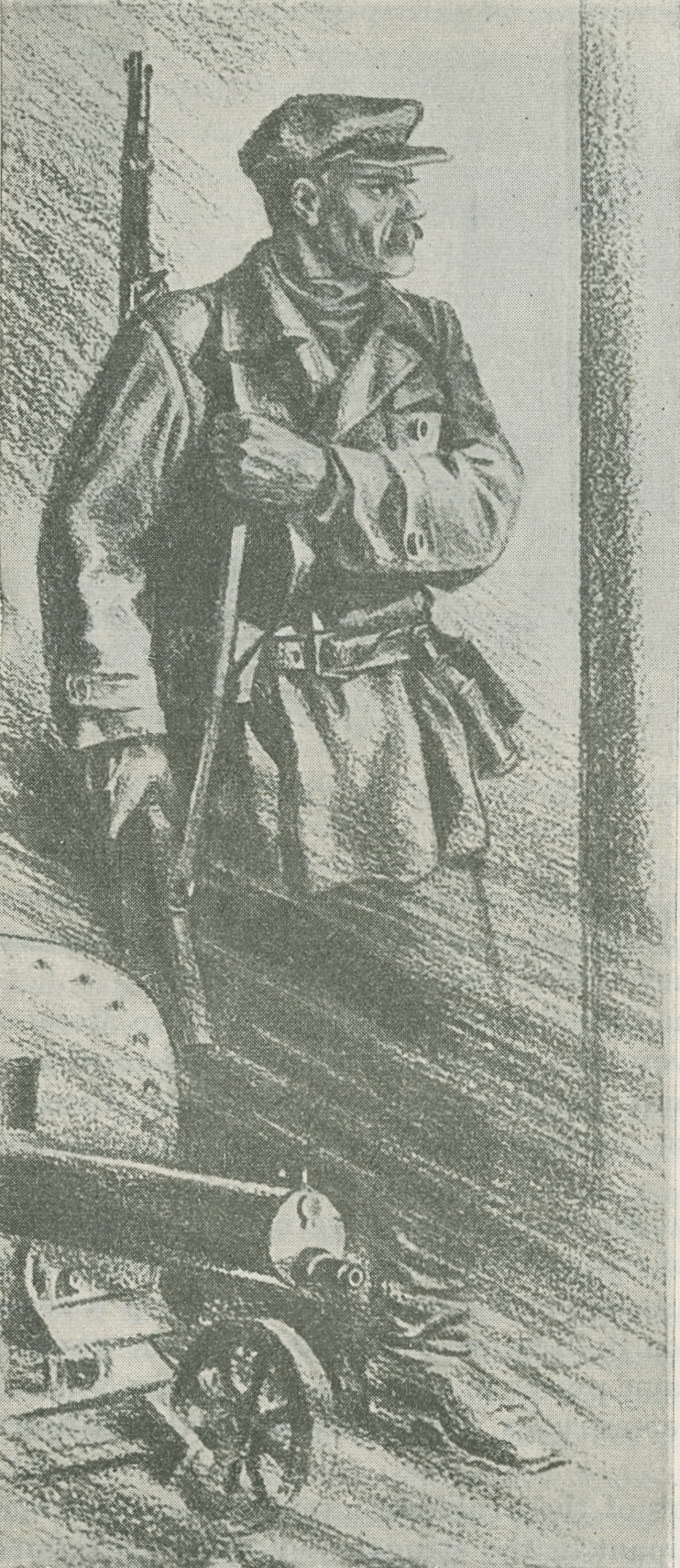
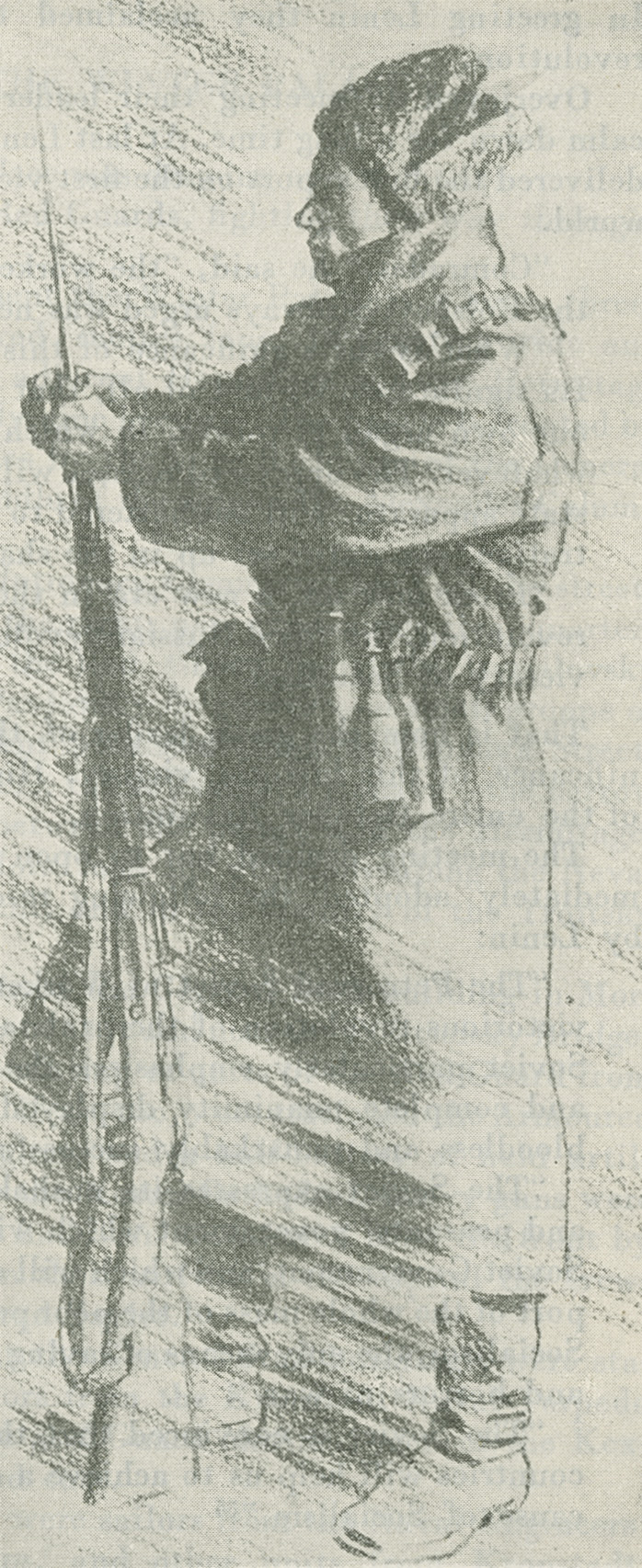
“In Petrograd power is in the hands of the Military Revolutionary Committee of the Petrograd Soviet of Workers’ and Soldiers’ Deputies. The soldiers and workers who unanimously rose in revolt achieved victory without bloodshed. The Kerensky government has been deposed.
“The Committee calls upon the front and the rear not to yield to provocation and to support the Petrograd Soviet and the new revolutionary government, which will immediately offer to conclude a just peace, transfer the land to the peasants and convene the Constituent Assembly. Local government must pass into the hands of the Soviets of Workers’, Soldiers’ and Peasants’ Deputies.”[8]
Telegrams were sent to the front calling upon the soldiers to prevent the dispatch of unreliable units; officers who failed openly and unreservedly to associate themselves with the revolution were to be immediately arrested as enemies.
In the room of the Military Revolutionary Committee were members of the Central Committee of the Bolshevik Party. Lenin and Stalin took a most active and decisive part in all the details of the work of the Military Revolutionary Committee. The most important documents, beginning with the manifesto announcing the overthrow of the Provisional Government, were written by Lenin. All appointments were made with his approval. He endorsed the most important of the orders issued by other leaders. Here Lenin drafted the resolution for the special meeting of the Petrograd Soviet of Workers’ and Soldiers’ Deputies.
This meeting opened at 2:35 p.m. on October 25 (November 7).
Amidst loud and prolonged applause the Military Revolutionary Committee announced the victory of the revolution. When Lenin—the organiser and inspirer of victory—entered the hall to make his first public appearance since the July days, the delegates jumped to their feet and gave the leader of the revolution a rousing ovation. When Lenin was called upon to speak the delegates rose again, and cheer after cheer rang through the hall. With a clatter of arms a unit of Red Guards entered the hall. They brought with them the smell of powder and the excitement of battle. In greeting Lenin they acclaimed their victory, the victory of the revolution.
Overjoyed at meeting their leader once again the delegates could not calm down for a long time. At last Lenin could make himself heard, and he delivered the first report on the first victorious proletarian revolution in the world.
“Comrades,” he said, “the workers’ and peasants’ revolution, which the Bolsheviks always urged was necessary, is an accomplished fact.
“What is the significance of this workers’ and peasants’ revolution? Its significance is, first of all, that we shall have a Soviet Government, our own organ of power, in which the bourgeoisie will have no share whatever. The oppressed masses will themselves create a power. The old state apparatus will be shattered to its foundations and a new administrative apparatus set up in the shape of the Soviet organisations.
“From now on, a new era in the history of Russia begins, and this revolution, the third Russian revolution, should, in the end, lead to the victory of Socialism.”[9]
That is how the great leader of the proletariat characterised the significance of this historic victory. His speech was the program of action of the entire October Revolution.
The meeting decided not to open a debate on Lenin’s report. It immediately adopted the following resolution, which had been drawn up by Lenin:
“The Petrograd Soviet of Workers’ and Soldiers’ Deputies hails the victorious revolution of the proletariat and garrison of Petrograd. The Soviet particularly emphasises the solidarity, organisation, discipline and complete unanimity displayed by the masses in this remarkably bloodless and remarkably successful insurrection.
“The Soviet expresses its unshakeable conviction that the workers’ and peasants’ government which will be created by the revolution as a Soviet Government, and which will ensure the urban proletariat the support of the whole mass of the poor peasantry, will firmly proceed towards Socialism, the only means of saving the country from the untold miseries and horrors of war. . . .
“The Soviet is convinced that the proletariat of the West-European countries will help us to achieve a complete and lasting victory for the cause of Socialism.”[10]
[1] “To the Citizens of Russia,” Rabochy Put, No. 46, October 26, 1917.
[2] “The Events of a Day,” Novaya Zhizn, No. 163, October 26, 1917.
[3] “In the Mariinsky Palace,” Rech, No. 252, October 26, 1917.
[4] “Documents,” Arkhiv Russkoi Revolutsii, Vol. VII, Berlin, 1922, p. 293.
[5] “A. M. Nikitin’s Story,” Rabochaya Gazeta, No. 198, October 28, 1917.
[6] “The Last Hours of the Provisional Government in 1917,” Krasny Arkhiv, 1933, Vol. I (56), p. 137.
[7] Sinegub, “The Defence of the Winter Palace on October 25, 1917,” Arkhiv Russkoi Revolutsii, Vol. IV, Berlin, 1922, p. 139.
[8] “Telegram of the Military Revolutionary Committee,” Rabochy Put, No. 46, October 26, 1917.
[9] V. I. Lenin, “Meeting of the Petrograd Soviet of Workers’ and Soldiers’ Deputies of November 7 (October 25), 1917,” Lenin and Stalin, 1917, Eng. ed., p. 614.
[10] Ibid., p. 615-16.
Previous: The Flight of Kerensky
Next: The Siege of the Winter Palace